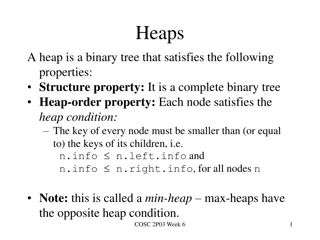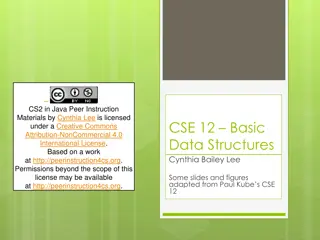Comprehensive Overview of Binary Heaps, Heapsort, and Hashing
In this detailed review, you will gain a thorough understanding of binary heaps, including insertion and removal operations, heap utility functions, heapsort, and the efficient Horner's Rule for polynomial evaluation. The content also covers the representation of binary heaps, building initial heaps, and the significance of hashing in data structures.
Download Presentation

Please find below an Image/Link to download the presentation.
The content on the website is provided AS IS for your information and personal use only. It may not be sold, licensed, or shared on other websites without obtaining consent from the author.If you encounter any issues during the download, it is possible that the publisher has removed the file from their server.
You are allowed to download the files provided on this website for personal or commercial use, subject to the condition that they are used lawfully. All files are the property of their respective owners.
The content on the website is provided AS IS for your information and personal use only. It may not be sold, licensed, or shared on other websites without obtaining consent from the author.
E N D
Presentation Transcript
MA/CSSE 473 Day 23 Review of Binary Heaps and Heapsort Overview of what you should know about hashing Answers to student questions
Binary (max) Heap Quick Review Representation change example See also Weiss, Chapter 21 (Weiss does min heaps) An almost-complete Binary Tree All levels, except possibly the last, are full On the last level all nodes are as far left as possible No parent is smaller than either of its children A great way to represent a Priority Queue Representing a binary heap as an array:
Insertion and RemoveMax Insert an item: Insert at the next position (end of the array) to maintain an almost-complete tree, then "percolate up" within the tree to restore heap property. RemoveMax: Move last element of the heap to replace the root, then "percolate down" to restore heap property. Both operations are (log n). Many more details (done for min-heaps): http://www.rose- hulman.edu/class/csse/csse230/201230/Slides/18- Heaps.pdf
Heap utilitiy functions Code is on-line, linked from the schedule page
HeapSort Arrange array into a heap. (details next slide) for i = n downto 2: a[1] a[i], then "reheapify" a[1]..a[i-1]
HeapSort: Build Initial Heap Two approaches: for i = 2 to n percolateUp(i) for j = n/2 downto 1 percolateDown(j) Which is faster, and why? What does this say about overall big-theta running time for HeapSort?
Polynomial Evaluation Problem Reductiion TRANSFORM AND CONQUER
Horner's Rule It involves a representation change. Instead of anxn + an-1xn-1+ . + a1x + a0, which requires a lot of multiplications, we write ( (anx + an-1)x + +a1 )x + a0 code on next slide
Horner's Rule Code This is clearly (n).
Problem Reduction Express an instance of a problem in terms of an instance of another problem that we already know how to solve. There needs to be a one-to-one mapping between problems in the original domain and problems in the new domain. Example: In quickhull, we reduced the problem of determining whether a point is to the left of a line to the problem of computing a simple 3x3 determinant. Example: Moldy chocolate problem in HW 9. The big question: What problem to reduce it to? (You'll answer that one in the homework)
Least Common Multiple Let m and n be integers. Find their LCM. Factoring is hard. But we can reduce the LCM problem to the GCD problem, and then use Euclid's algorithm. Note that lcm(m,n) gcd(m,n) = m n This makes it easy to find lcm(m,n)
Paths and Adjacency Matrices We can count paths from A to B in a graph by looking at powers of the graph's adjacency matrix. For this example, I used the applet from http://oneweb.utc.edu/~Christopher-Mawata/petersen2/lesson7.htm, which is no longer accessible
Linear programming We want to maximize/minimize a linear function , subject to constraints, which are linear equations or inequalities involving the n variables x1, ,xn . The constraints define a region, so we seek to maximize the function within that region. If the function has a maximum or minimum in the region it happens at one of the vertices of the convex hull of the region. The simplex method is a well-known algorithm for solving linear programming problems. We will not deal with it in this course. The Operations Research courses cover linear programming in some detail. n = i c ix i 1
Integer Programming A linear programming problem is called an integer programming problem if the values of the variables must all be integers. The knapsack problem can be reduced to an integer programming problem: maximize subject to the constraints and xi {0, 1} for i=1, , n n =1 x iv i i n = i x w W i i 1
Sometimes using a little more space saves a lot of time SPACE-TIME TRADEOFFS
Space vs time tradeoffs Often we can find a faster algorithm if we are willing to use additional space. Examples:
Space vs time tradeoffs Often we can find a faster algorithm if we are willing to use additional space. Give some examples (quiz question) Examples: Binary heap vs simple sorted array. Uses one extra array position Merge sort Radix sort and Bucket Sort Anagram finder Binary Search Tree (extra space for the pointers) AVL Tree (extra space for the balance code)
Hashing Highlights We cover this pretty thoroughly in CSSE 230, and Levitin does a good job of reviewing it concisely, so I'll have you read it on your own (section 7.3). On the next slides you'll find a list of things you should know (some of them expressed here as questions) Details in Levitin section 7.3 and Weiss chapter 20. Outline of what you need to know is on the next slides. Will not cover them in great detail in class, since they are typically covered well in 230. Today: talk with students near you and answer the last two questions on today's handout.
Hashing You should know, part 1 Hash table logically contains key-value pairs. Represented as an array of size m. H[0..m-1] Typically m is larger than the number of pairs currently in the table. Hash function h(K) takes key K to a number in range 0..m Hash function goals: Distribute keys as evenly as possible in the table. Easy to compute. Does not require m to be a lot larger than the number of keys in the table.
Hashing You should know, part 2 Load factor: ratio of used table slots to total table slots. Smaller better time efficiency (fewer collisions) Larger better space efficiency Two main approaches to collision resolution Open addressing Se Open addressing basic idea When there is a collision during insertion, systematically check later slots (with wraparound) until we find an empty spot. When searching, we systematically move through the array in the same way we did upon insertion until we find the key we are looking for or an empty slot.
Hashing You should know, part 3 Open addressing linear probing When there is a collision, check the next cell, then the next one, , (with wraparound) Let be the load factor, and let S and U be the expected number of probes for successful and unsuccessful searches. Expected values for S and U are
Hashing You should know, part 4 Open addressing double hashing When there is a collision, use another hash function s(K) to decide how much to increment by when searching for an empty location in the table So we look in H(k), H(k) + s(k), H(k) + 2s(k), , with everything being done mod m. If we we want to utilize all possible array positions, gcd(m, s(k)) must be 1. If m is prime, this will happen.
Hashing You should know, part 5 Separate chaining Each of the m positions in the array contains a link ot a structure (perhaps a linked list) that can hold multiple values. Does not have the clustering problem that can come from open addressing. For more details, including quadratic probing, see Weiss Chapter 20 or my CSSE 230 slides (linked from the schedule page)























